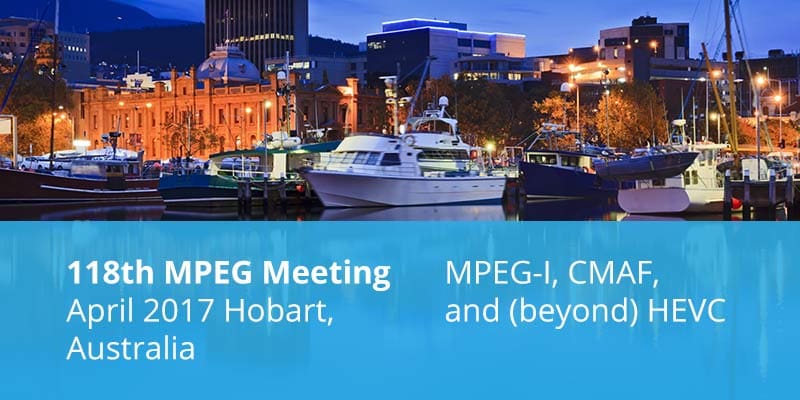
The 118th MPEG meeting concluded on April 7, 2017 in Hobart, Australia and featured topics such as MPEG-I, CMAF, and (beyond) HEVC. If you’re not familiar yet with these acronyms (or parts thereof), keep on reading …
The entire MPEG press release can be found here comprising the following topics:
- Coded Representation of Immersive Media (MPEG-I): new work item approved and call for test data issued
- Common Media Application Format (CMAF): FDIS approved
- Beyond High Efficiency Video Coding (HEVC): call for evidence for “beyond HEVC” and verification tests for screen content coding extensions of HEVC
Coded Representation of Immersive Media (MPEG-I)
MPEG has started work on the new work item referred to as ISO/IEC 23090 with the “nickname” MPEG-I which targets future immersive applications. The goal of this new standard is to enable various forms of audio-visual immersion, including panoramic video with 2D and 3D audio, with various degrees of true 3D visual perception. It currently comprises five parts: (pt. 1) a technical report describing the scope of this new standard and a set of use cases and applications; (pt. 2) an application format for omnidirectional media (aka OMAF) to address the urgent need of the industry for a standard is this area; (pt. 3) immersive video which is a kind of placeholder for the successor of HEVC (if at all); (pt. 4) immersive audio as a placeholder for the successor of 3D audio (if at all); and (pt. 5) for point cloud compression. The point cloud compression standard targets lossy compression for point clouds in real-time communication, six Degrees of Freedom (6 DoF) virtual reality, and the dynamic mapping for autonomous driving, cultural heritage applications, etc. Part 2 is related to OMAF which I have discussed in one of my previous blog posts.
MPEG also established an Ad-hoc Group (AhG) on immersive Media quality evaluation with the following mandates: 1. Produce a document on VR QoE requirements; 2. Collect test material with immersive video and audio signals; 3. Study existing methods to assess human perception and reaction to VR stimuli; 4. Develop test methodology for immersive media, including simultaneous video and audio; 5. Study VR experience metrics and their measurability in VR services and devices. AhGs are open to everybody and mostly discussed using mailing lists (join here https://lists.aau.at/mailman/listinfo/immersive-quality). Interestingly, a Joint Qualinet-VQEG team on Immersive Media (JQVIM) has been recently established with similar goals and also the VR Industry Forum (VRIF) has issued a call for VR360 content. It seems there’s a strong need for a dataset similar to the one we have created for MPEG-DASH long time ago.
Common Media Application Format (CMAF)
The Final Draft International Standard (FDIS) has been issued at the 118th MPEG meeting which concludes the formal technical development process of the standard. At this point in time national bodies can only vote Yes|No and editorial changes are allowed (if any) before the International Standard (IS) becomes available. The goal of CMAF is to define a single format for the transport and storage of segmented media including audio/video formats, subtitles, and encryption — it is derived from the ISO Base Media File Format (ISOBMFF). As it’s a combination of various MPEG standard it’s referred to as an Application Format (AS) which mainly takes existing formats/standards and glues them together for a specific target application. The CMAF standard clearly targets dynamic adaptive streaming (over — but not limited to — HTTP) but focusing on the media format only and excluding the manifest format. Thus, the CMAF standard shall be compatible with other formats such as MPEG-DASH and HLS. In fact, HLS has been extended already some time ago to support ‘fragmented MP4’ which we have demonstrated also and it has been interpreted as a first step towards the harmonization of MPEG-DASH and HLS; at least on the segment format. The delivery of CMAF contents with DASH will be described in part 7 of MPEG-DASH that basically comprises a mapping of CMAF concepts to DASH terms.
The CMAF FDIS is not yet available at the time of writing this blog post (due to editing period) and we will provide further details about CMAF (what’s in and what’s not) in a later blog post.
Beyond HEVC…
The preliminary call for evidence (CfE) on video compression with capability beyond HEVC has been issued and is addressed to interested parties that have technology providing better compression capability than the existing standard, either for conventional video material, or for other domains such as HDR/WCG or 360-degree (“VR”) video. Test cases are defined for SDR, HDR, and 360-degree content. This call has been made jointly by ISO/IEC MPEG and ITU-T SG16/Q6 (VCEG). The evaluation of the responses is scheduled for July 2017 and depending on the outcome of the CfE, the parent bodies of the Joint Video Exploration Team (JVET) of MPEG and VCEG collaboration intend to issue a Draft Call for Proposals by the end of the July meeting.
Finally, verification tests have been conducted for the Screen Content Coding (SCC) extensions to HEVC showing exceptional performance. Screen content is video containing a significant proportion of rendered (moving or static) graphics, text, or animation rather than, or in addition to, camera-captured video scenes. For scenes containing a substantial amount of text and graphics, the tests showed a major benefit in compression capability for the new extensions over both the Advanced Video Coding standard and the previous version of the newer HEVC standard without the new SCC features.
The question whether and how new codecs like (beyond) HEVC competes with AV1 is yet to be explored but that’s another story..
Publicly available documents from the 118th MPEG meeting can be found here (scroll down to the end of the page). The next MPEG meeting will be held in Torino, Italy, July 17-21, 2017. Feel free to contact us for any questions or comments.




